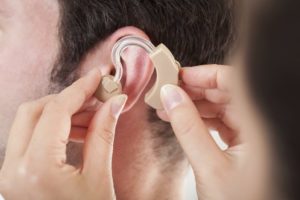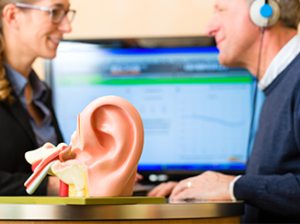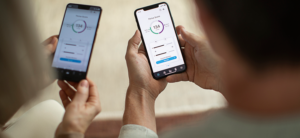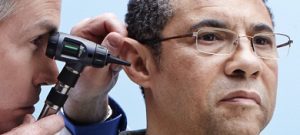Services you should expect
At your hearing assessment appointment your HHP will ask you a series of questions about your hearing health, your medical history and the situations where you’re having communication difficulties.
They will then look in your ears with an otoscope to check your ear canals are clear. If wax removal is required, they’ll let you know. Once your ears are deemed clear, the hearing test can begin.
The hearing test will follow a set protocol for most clinics and generally include a middle ear test, an audiometry assessment, a speech test and discussion of your results.
Once this has been completed your HHP should discuss your options with you. Depending on the results of your hearing assessment, these could include:
- Hearing within normal limits – retest your hearing every 12 months (just like you do with your vision checks).
- Referral back to your doctor – if a medical issue has been detected and treatment and/or further testing is required.
- Rehabilitation options if a hearing loss has been detected (that can’t be medically treated) – a hearing device is recommended.

Ethical practice
At this stage you may want to go away and think about the results, or get a second opinion – and that’s fine.
Don’t be pushed into making a decision if you’re not ready. Otherwise you may be ready to discuss hearing devices and in some clinics you can actually be fitted with a trial device there and then.
Your HHP has guidelines to follow for the selection and fitting of hearing devices, to ensure an ethical process is adhered to.

These guidelines include:
- Hearing device discussion – you may already have clear ideas of the type of hearing device you want. Discuss this with your HHP to see if your hearing is appropriate for the hearing aid you want. Every hearing loss, every ear, every person has different requirements and some hearing aids may not suit your particular hearing needs. Have an open mind and listen to your HHP if they think the one you’ve suggested won’t suit you. For example, if you want an invisible hearing aid in the ear canal, but are prone to wax build up or you have a very narrow ear canal, your clinician may suggest an alternative. The discussion should include your lifestyle – how active you are, your communication requirements, if you want to stream phone calls, if you want rechargeable batteries and how much you want to pay. Be wary of ‘upselling’ to a technology level that either you can’t afford, or isn’t appropriate for your hearing. Together with your clinician, you’ll make a decision on the brand, model and style of hearing aid. Make sure you understand why your clinician is recommending a certain type of device and what the specific features are. If you’re not sure on anything, ask for clarification.
- Get a quote for the hearing aid and what the price covers (hearing aid, accessories, batteries, clinician’s time, warranty etc.). Confirm the length of the free trial period.
- Taking an impression of your ear if required. Not all hearing aids required a custom made ear mould – but if yours does, then the impression will be required. Your hearing aid will be ordered and a fitting appointment organised. However, your clinician may also offer you a trial hearing aid that can be fitted immediately.
- The hearing aid fitting appointment – if possible, bring a support person with you. There’s a lot to take in and sometimes it’s better to have a second pair of ears listening, just in case you forget something. There are a several things that must happen in this appointment – so don’t leave the appointment until you are comfortable with the following:
- How the to put your hearing aid in correctly
- How your hearing aid sounds (not too loud, or too tinny, or you just don’t like the sound of it) and feels in your ear – is shouldn’t be uncomfortable or hurt any section of your ear.
- How to clean and maintain your hearing aid
- How to change the battery or charge the hearing aid with the rechargeable battery.

The clinician should also carry out the following:
- Real ear measurements – checking that the hearing aid is working in your ear to the prescribed specifications.
- Speech tests – with and without your hearing aids on, so you can hear the difference in your hearing with the hearing aids on.
- Listening program – a guide for you to follow on where and when to use your hearing aids. Some listening situations are tougher than others and you may wish to build up to these. However the more you use your hearing aids, the quicker you’ll acclimatise to them.
- Set up streaming accessories – if you’ve chosen a hearing aid that uses an app on your smartphone, you’ll be shown you how to set this up and use the controls.

Before you leave the fitting appointment, check once again you’re comfortable with putting your hearing aid in and removing it.
Ask any questions you may have. Ensure you understand what your options might be if the hearing aid is not what you expected, how long the trial period is, and that you can return the hearing aid if you aren’t happy with it. If you’re claiming the purchase of your hearing aid on your health insurance, get an official invoice from your HHP.
A follow up appointment should be booked so your clinician can check how you’re going and you can bring up any issues you’ve had. Some clinics offer virtual appointments if it’s difficult for you to attend the clinic.
A first fit is not always perfect so write down any problems you have before your follow-up appointment and bring them up at your follow up appointment – to ensure they get attended to.
If you’re not happy with any aspect of your hearing aid, you must tell your clinician. They want your hearing journey to be successful just as much as you do.

Meeting industry standards
Australian Audiologists work with clients of all ages – from infants to older adults – and clients with complex needs. Australian Audiometrists primarily work with adult clients and provide a range of services to school-aged children.
Both HHP groups have a focus on hearing and auditory function assessment, rehabilitation and the fitting of hearing aids.
All HHPs have a Scope of Practice to adhere to, where industry standards are set and monitored by the clinician’s relative industry body. If the HHP is a provider of hearing aids under the Australian Government Hearing Services Program (HSP), they are expected to also comply with legislative program requirements (Hearing Services Administration Act 1997) and a Service Provider Contract.
The HSP runs regular audits and monitoring programs to ensure service providers in this program meet the set industry and legislative standards.
Next Article –> Hearing Clinics: Big company vs Private provider
Previous Article –> Audiologist vs Audiometrist
